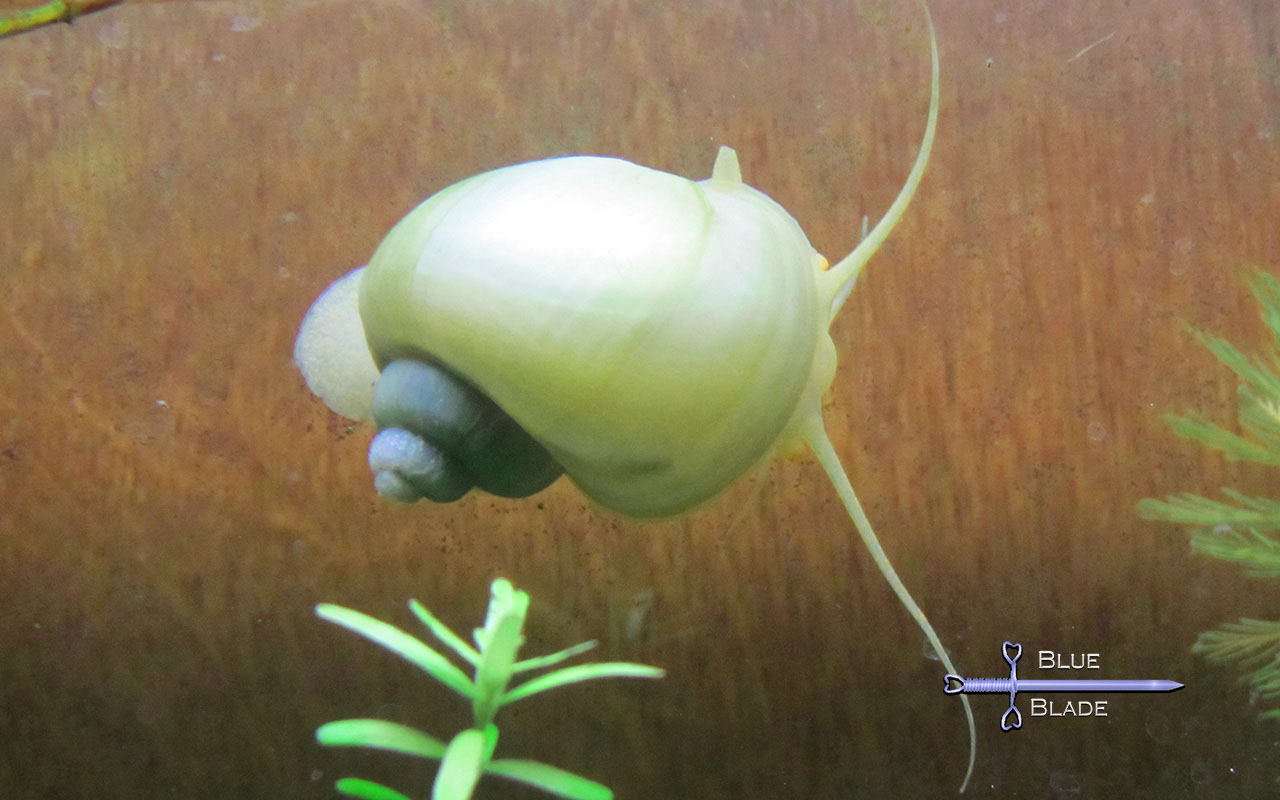
Whether you keep them for utility or personality, Snails are an excellent addition to *almost* any aquarium. They help in cleaning the tank by eating any food and waste that settles to the bottom and by grazing on algae that may cover rocks and decorations.
Please do consider which fish you keep - as many larger cichlids love to snack on even large snails.
We Breed and raise several species and varieties:

These make the best pet snails for your aquarium. They are large (growing to an inch and a half in diameter) come in several colors, and are easy to keep. They have a surprising amount of personality and are very active - cruising all over the tank all day long. They generally do not eat live plants, but if they are very hungry, they will snack on duckweed or frogbit.
Mystery Snails reproduce sexually and if you have a mature male and female they may lay their eggs above the waterline in hard cocoon like deposits. If you don't want too many snails in your tank, the eggs are easy to remove and dispose of. They do best in harder alkaline water - as acidic conditions will erode their shells. They absolutely love green beans.
Mystery Snails have both lungs and gills and can be seen frequently at the waterline or even out of the water exploring. We ship them without water, with a damp paper towel and/or some plants to keep them from drying out.
We currently breed 4 color varieties, with more on the way:
"Magenta"
Magenta Mystery Snails have a light colored foot and are a bright magenta when small.
As they grow, they may gain stripes that are darker and redder.
I almost always have some Magenta Mystery Snails avliable - check AquaBid and my GetGills store or contact us at contact@bluebladefish.com
"Ivory"
the Ivory snails have a light-colored foot and a light peach to white shell - like ivory.
"Blue"
The "Blue" snails have a dark foot and a translucent white shell.
The light refraction through the shell can give them a slight pearlescent blue color in the right light.
But to be honest, they are mostly grey.
"Chestnut"
the Chestnut colored snails have a light-colored foot, and when very small their shells are an orange/gold color.
As they grow, they gain stripes that are dark red/brown. This color variety is closest to the wild type, and has the most variation and best hatch rate.
I almost always have some Chestnut Mystery Snails avliable - check AquaBid and my GetGills store or contact us at contact@bluebladefish.com
"Gold"
the "Gold" colored snails have a light-colored foot, and their shells are a Yellow/Gold color.
They do not gain stripes as they grow, with the shells staying that solid Yellow/Gold. These are the newest addition to our snail herd, and should be avliable soon.
More
Spixi snails are slightly smaller than mystery snails growing to just a tad over an inch. They are very resilient but prefer warmer waters to breed. When the tank gets warmer than about 76 degrees F they are known to mate and lay large gelatinous egg sacks on plants or structures in the tank. Like mystery snails they also have lungs but they are much less prone to leave the water. They love a sandy substrate and if the water gets cold they will burrow down for warmth.
Spixi snails have been reported to eat hydra. I have never seen this happen, but I also have never seen any hydra in any tank with spixi snails. The adults are plant safe, preferring to graze on algae and detritus. However, the baby snails may graze on soft leaves - particularly new sprouts from crypts or swords.
Unfortunately, they share a Genus with other snails that are a potential nuisance to agriculture. the whole group is restricted. These snails are only available (from me) for purchase in Texas where I breed them - I cannot ship them to an out-of-state address.
Often considered a pest snail because they are known to reproduce fast and can be unsightly when in great numbers, these snails can still be a great asset to a fish room. They are small - only growing slightly larger than half an inch - and do a fantastic job of converting fish waste and uneaten food into a hard sand-like snail poo that is easy to vacuum up while not polluting the water. They can breathe air. And because they reproduce so fast they are easy to come by.
I use Ramshorn snails in all small tanks (less than 2 gal). Usually with fry, as they allow me to feed more without as much worry about pollution.
We currently have the common black/brown variety, and a new red/pink line bred by a fellow local hobbyist. We do not generally list them for sale due to how common they are, but they can be made available upon request.
We have had some luck breeding Virgin Nerite (Neritina virginea) snails and may occasionally have enough to offer for sale. They are a fantastic addition to your clean up crew, scouring down to the rock and getting into small crevices. However, these snails only grow to about 3/8ths of an inch, and therefore do not each much - I consider them the rock polishers - getting the last residue that the other larger cleaners missed.
To get your own snails follow the links under "Buy Here"
Or contact us at contact@bluebladefish.com